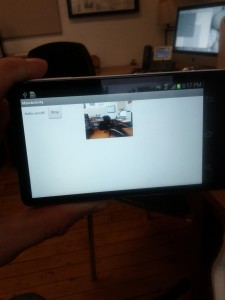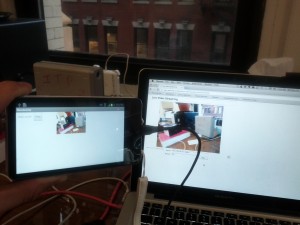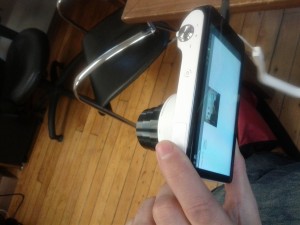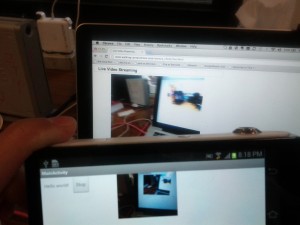One of my students in my live web class is developing an interesting application that sends screenshots to other people. I put together some sample code to help him along and thought this would be of general interest.
Using the Flash Media Server with Remote Shared Objects this can be built. Here is a walk through of the code:
First of all, this uses the JPGEncoder class from the AS3CoreLib so you probably want to grab that and import it.
import com.adobe.images.JPGEncoder;
This example uses a SharedObject, a NetConnection and NetStreams for sending the video as well as the screen shots. Once the NetConnection is established, the SharedObject can be setup:
// Listener for connection
private function connectionHandler (e:NetStatusEvent):void
{
// If we are connected
if (e.info.code == "NetConnection.Connect.Success")
{
// Set up the shared object
// We'll call it SimpleSO, pass in the app url and not make it persistent
sharedObject = SharedObject.getRemote("SimpleSO",nc.uri,false);
// Tell the shared object to call methods in this class if requested
sharedObject.client = this;
// Add a listener for when shared object is changed
sharedObject.addEventListener (SyncEvent.SYNC,syncEventCallBack);
// Connect the shared object to our netConnection
sharedObject.connect(nc);
// All of the video streaming setup
doEverything();
// Register mouseclicks, how we'll determine when to send a frame
stage.addEventListener(MouseEvent.MOUSE_DOWN, saveFrame);
}
}
Here is the method that is called when the mouse is clicked. It creates a bitmapdata object, encodes as a JPEG and sends that as a bytearray through the shared object:
private function saveFrame(e:MouseEvent):void
{
// Save the frame to the bitmapdata object
var bmpd:BitmapData = new BitmapData(320,240);
bmpd.draw(videoIn1);
// First encode as JPEG so it is smaller
var jpgEncoder:JPGEncoder = new JPGEncoder(100);
var jpgByteArray:ByteArray = jpgEncoder.encode(bmpd);
// Send it via the shared object
sharedObject.send("newBitmap",jpgByteArray);
}
The SharedObject.send method calls the function “newBitmap” on everyone who is connected and passes in the jpgByteArray. The newBitmap function uses the Loader to uncompress the JPG and when it is done calls “gotBitmapData”:
public function newBitmap(jpgByteArray:ByteArray):void
{
var loader:Loader = new Loader();
loader.contentLoaderInfo.addEventListener(Event.COMPLETE, gotBitmapData)
loader.loadBytes(jpgByteArray);
}
gotBitmap data just creates a regular Bitmap and displays it:
private function gotBitmapData(e:Event):void
{
var decodedBitmapData:BitmapData = Bitmap(e.target.content).bitmapData
// Create the bitmap image
var bmp:Bitmap = new Bitmap(decodedBitmapData);
// Add it to the stage
bmp.x = 0;
bmp.y = 240;
addChild(bmp);
}
Here is the full AS3 class (it could be improved but it works):
package
{
// Import JPEGEncoder Class from: http://code.google.com/p/as3corelib/
import com.adobe.images.JPGEncoder;
import flash.display.Sprite;
import flash.display.MovieClip;
import flash.events.NetStatusEvent;
import flash.net.NetConnection;
import flash.net.NetStream;
import flash.media.Camera;
import flash.media.Microphone;
import flash.media.Video;
import flash.display.Bitmap;
import flash.display.BitmapData;
import flash.events.MouseEvent;
import flash.utils.ByteArray;
import flash.net.SharedObject;
import flash.events.SyncEvent;
import flash.events.Event;
import flash.display.Loader;
public class VideoCapture extends Sprite
{
// Shared Object for communication
private var sharedObject:SharedObject;
// Overall NetConnection for communicating with FMS
private var nc:NetConnection;
// RTMP URL, same as directory on FMS
private var rtmpURL:String = "rtmp://xxxx/webcam";
// NetStreams for each stream
private var netStreamOut:NetStream;
private var netStreamIn1:NetStream;
// Camera
private var camera:Camera;
// Microphone
private var microphone:Microphone;
// My Video
private var videoOut:Video;
// Video Components
private var videoIn1:Video;
// Stream Names
private var outStream:String;
private var inStream1:String;
public function VideoCapture()
{
// Construct NetConnection and connect to server
nc = new NetConnection();
nc.connect(rtmpURL);
// Add a listener for connection
nc.addEventListener (NetStatusEvent.NET_STATUS,connectionHandler);
}
// Listener for connection
private function connectionHandler (e:NetStatusEvent):void
{
// If we are connected
if (e.info.code == "NetConnection.Connect.Success")
{
// Set up the shared object
// We'll call it SimpleSO, pass in the app url and not make it persistent
sharedObject = SharedObject.getRemote("SimpleSO",nc.uri,false);
// Tell the shared object to call methods in this class if requested
sharedObject.client = this;
// Connect the shared object to our netConnection
sharedObject.connect(nc);
// All of the video streaming
doEverything();
// Register mouseclicks, how we'll determine when to send a frame
stage.addEventListener(MouseEvent.MOUSE_DOWN, saveFrame);
}
}
// Gets the results from the server
private function doEverything():void
{
// Name of streams
outStream="one";
inStream1="one";
// Setup the camera
camera = Camera.getCamera();
// setup the microphone
microphone = Microphone.getMicrophone();
// Video components
videoOut = new Video();
videoIn1 = new Video();
// Set positions
videoOut.x = 0;
videoOut.y = 0;
videoIn1.x = 320;
videoIn1.y = 0;
// Add them to the screen
addChild(videoOut);
addChild(videoIn1);
// Publish our stream
netStreamOut = new NetStream(nc);
netStreamOut.attachAudio(microphone);
netStreamOut.attachCamera(camera);
netStreamOut.publish(outStream, "live");
// Attach camera to our video
videoOut.attachCamera(camera);
//Play incoming streamed video
netStreamIn1 = new NetStream(nc);
videoIn1.attachNetStream(netStreamIn1);
netStreamIn1.play(inStream1);
}
private function saveFrame(e:MouseEvent):void
{
// Save the frame to the bitmapdata object
var bmpd:BitmapData = new BitmapData(320,240);
bmpd.draw(videoIn1);
// First encode as JPEG so it is smaller
var jpgEncoder:JPGEncoder = new JPGEncoder(100);
var jpgByteArray:ByteArray = jpgEncoder.encode(bmpd);
// Send it via the shared object
sharedObject.send("newBitmap",jpgByteArray);
}
public function newBitmap(jpgByteArray:ByteArray):void
{
var loader:Loader = new Loader();
loader.contentLoaderInfo.addEventListener(Event.COMPLETE, gotBitmapData)
loader.loadBytes(jpgByteArray);
}
private function gotBitmapData(e:Event):void
{
var decodedBitmapData:BitmapData = Bitmap(e.target.content).bitmapData
// Create the bitmap image
var bmp:Bitmap = new Bitmap(decodedBitmapData);
// Add it to the stage
bmp.x = 0;
bmp.y = 240;
addChild(bmp);
}
}
}



